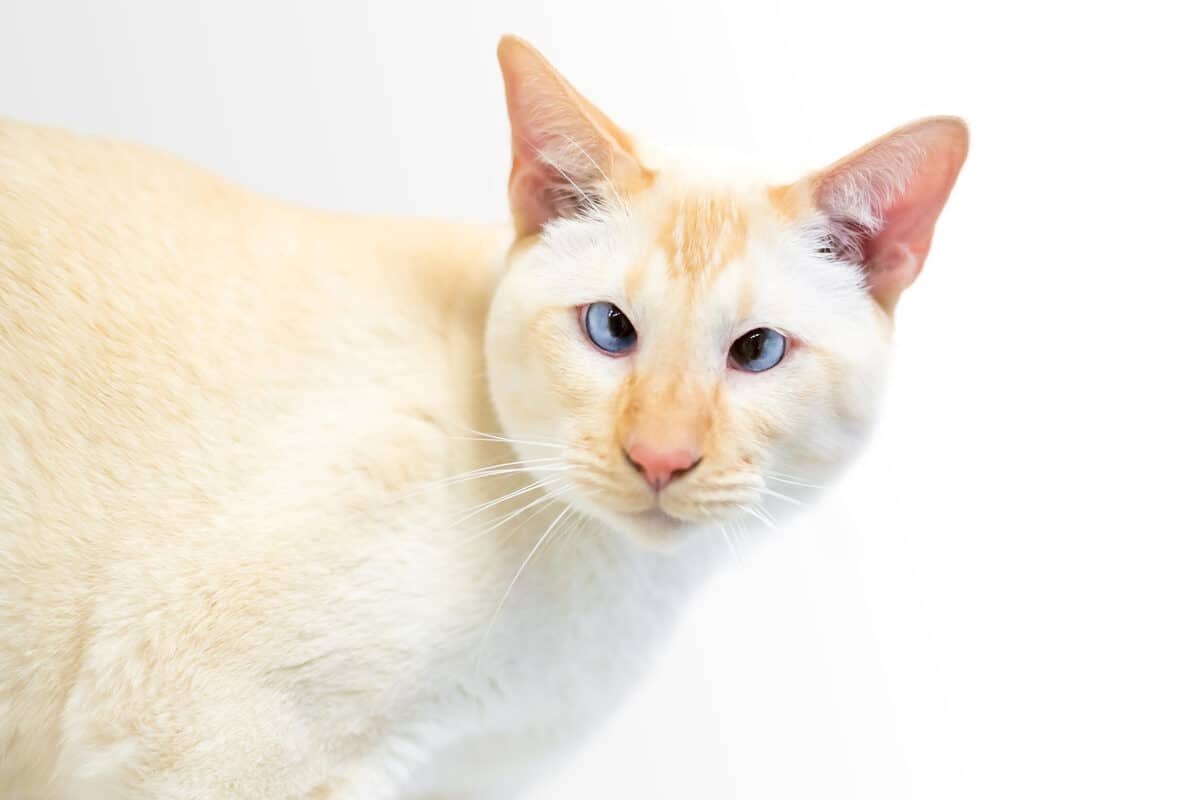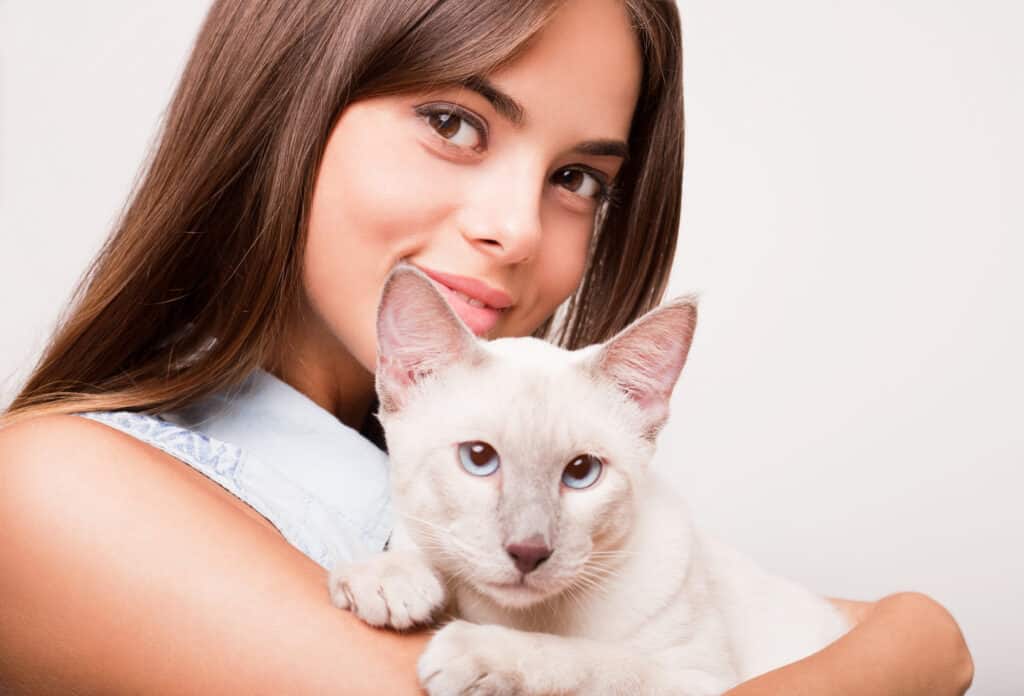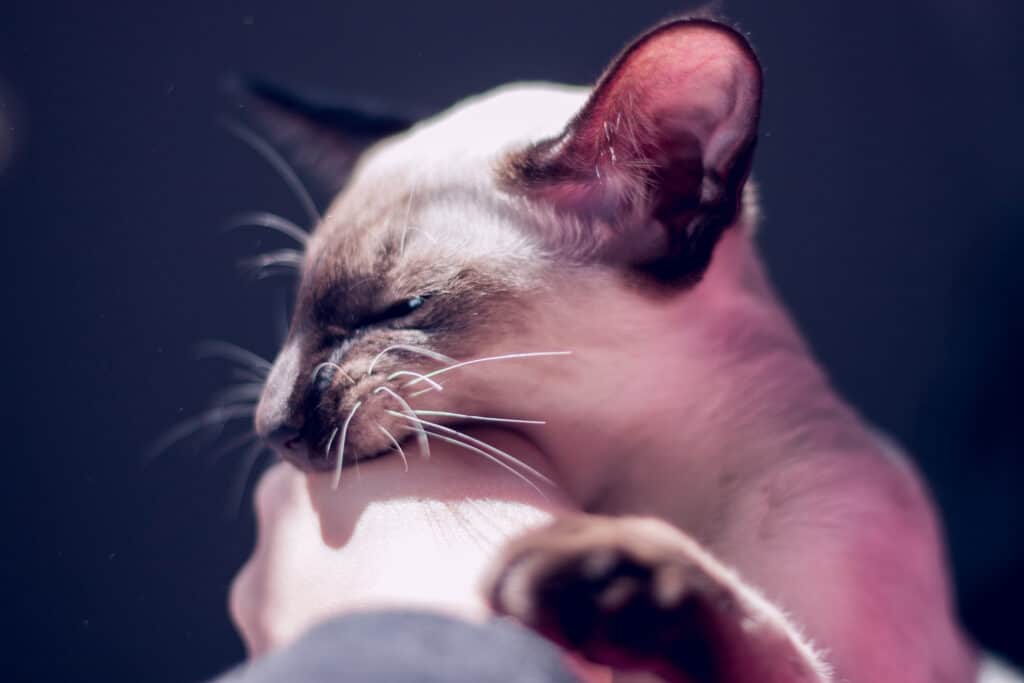Siamese cats are a unique breed of cats. Their playful personality, emotional temper tantrums, and chatty nature make them great pets for many homes.
However, if you’re scouting out a Siamese forever friend to bring home with you and notice that they’re cross-eyed…
Don’t worry!
Many Siamese cats are cross-eyed, and the condition doesn’t significantly affect their quality of life.
What is causing Siamese cats to be cross-eyed?
Siamese cats are cross-eyed due to a genetic condition called “convergent strabismus”, brought on by genetically bred temperature-sensitive albinism. Because a muscle in the inner side of the eye is too short, the retina is slightly tilted, causing the eyes to look inward slightly.
Despite being cross-eyed, most cross-eyed Siamese cats can still live a happy and fulfilled life.
There’s a lot of fascinating science behind why this trait has been bred into Siamese cats, and the rest of this article will go into depth on cross-eyed Siamese cats and how to properly care for them.
Why Are Siamese Cats Cross-Eyed?
It will likely not surprise you that the cross-eyed trait in Siamese cats is a side effect of selective breeding and manipulation of the gene pool.
To explain why Siamese cats are cross-eyed, we first need to discuss their beautiful blue eyes.
As it turns out, strabismus, as the ‘cross-eyed condition’ is officially called, is caused by the same gene that gives Siamese cats distinctive blue eyes.
How is this possible, I hear you ask? Well, I’ll explain…
For Siamese cats to have those brilliant blue eyes carried on through the breed standard, breeders had to pair two parents with temperature-sensitive albinism.
This condition causes pigments in their coat and eyes to be inert, causing them to lack color, also called albinism.
But if their eyes have no color pigments, how can they be blue?
This is because the beautiful blue you see in your Siamese cat’s eyes isn’t a result of pigmentation; it’s the light reflected off the ‘stroma’ layer of the eye.
Without getting too technical, the stroma is part of our eyes’ cornea, the transparent layer.
Hence, their blue eyes aren’t actually colored blue; it’s a reflection of the eye itself, which we see as light blue.
Suggested reading: Common Eye Problems with Siamese Cats.
Why are not all Siamese cats cross-eyed?
The likelihood of a Siamese cat with temperature-sensitive albinism developing strabismus (cross-eyedness) increased significantly throughout the genealogical line.
This was mainly caused by inbreeding, a common risk with purebred cats.
Prevalent as the trait may be, not all Siamese cats are cross-eyed, but if they are going to be, the congenital condition will typically manifest itself at birth.
In recent years, people actually preferred Siamese cats that are not cross-eyed, and breeders have picked up on that.
Now they are consciously crossing non-cross-eyed Siamese cats to ‘breed out’ the strabismus.
Again, being cross-eyed rarely affects a cat’s quality of life. If it’s a condition your Siamese was born with, you can rest assured that it’s only a genetic defect that isn’t usually indicative of more severe problems with the eye.
Do cross-eyed Siamese cats have vision problems?
According to Dr. Francine Rattner (a veterinarian at VCA South Arundel Animal Hospital in Edgewater), Siamese cats with Strabismus rarely cope with vision problems as the brain corrects the image. However, research shows that this condition impacts a cat’s night vision.
Health Concerns for a Cat with Strabismus
If your Siamese cat is cross-eyed, you can rest assured that it doesn’t typically affect their quality of life.
That being said, if your Siamese cat develops strabismus as an adult, you should visit the doctor to see if there are any underlying issues causing the onset of the condition.
Visit your vet immediately if you notice any of the following symptoms:
- Rapid eye movements
- Different sized pupils
- Lack of constriction when exposed to light
- Droopy eyelid
- Bulging eye
- Lethargy and dizziness
- Consistently tilting to one side
These symptoms indicate a more severe condition and should be checked out by your veterinarian quickly.
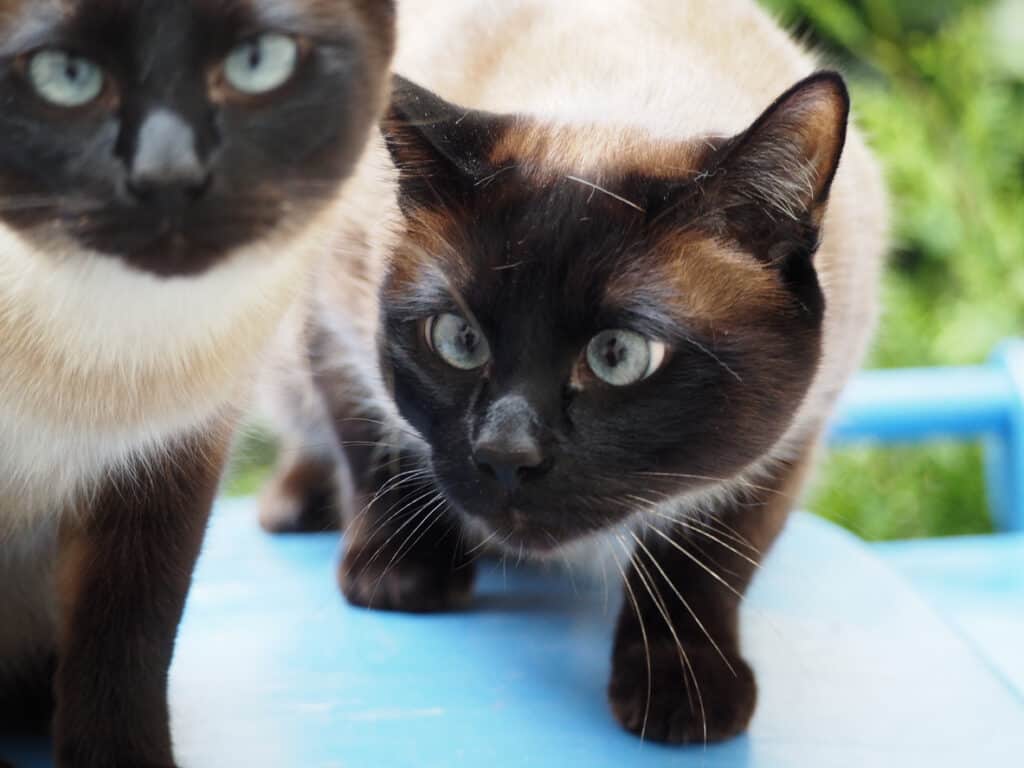
What about developing crossed eyes later in life?
If your Siamese cat often develops strabismus, your doctor will evaluate the severity of the condition and determine whether surgery is needed.
To diagnose the condition, your veterinarian will perform a comprehensive panel of tests, including how sensitive your cat is to light, eye pressure testing, tear tests, and eye staining.
If the condition is hereditary (typically in Siamese cats), the veterinarian will usually recommend no further action because the condition isn’t likely to cause other problems.
Suppose it’s not hereditary and poses a risk to the cat’s health down the line. In that case, your veterinarian may recommend surgery to correct strabismus, potentially addressing the root cause of the imbalance in the eye.
Depending on the underlying cause, some medications may also treat strabismus.
Because Siamese cats can struggle under anesthesia more than other breeds, and depending on your cat’s physical health and age, your veterinarian may recommend physical therapy to strengthen your cat’s eye instead.
How to Care for a Cross-Eyed Cat
So, now that you know what causes cats to be cross-eyed and know the warning signs of more serious problems, how does that translate to a home environment?
Cross-eyed cats don’t have the same depth perception or peripheral vision as other cats. It would be best to avoid having them climb up to high places.
Keeping a cat from climbing is like telling a fish not to swim, but you can try to accomplish this by not providing access to high places in your home.
Barring off access to high places and removing your cabinet-climbing adventurer will help them avoid misjudging a jump and hurting themselves.
In addition, all Siamese cats, cross-eyed or not, have reduced night vision due to how the lack of pigmentation in their eyes alters their structure.
While there are some special challenges with Siamese cats, especially cross-eyed ones, their quality of life is rarely ever impacted, and their personality is more than peppy enough to overcome the hardship.
Our Final Thoughts
Many Siamese cats are cross-eyed, which is caused by the same gene that gives them their beautiful temperature-sensitive coat. Not all Siamese cats have this condition, and breeders have been trying to remove it by crossing non-cross-eyed Siamese cats.
Apart from minor inconveniences such as a lack of night-sight and difficulty seeing distance, this condition rarely negatively impacts your cat’s quality of life.
If your cat (Siamese or not) develops cross-eyedness later, it’s wise to consult a vet.
Enjoy reading about Siamese cats?
Then you will love our other content about this magnificent breed. Have a look at these other posts on our website.
Our most popular article:
Introduction to Siamese Cats
Everything you need to know.
Or have a look at these popular reads from our website…
-

Why Do Siamese Cats Always Have Blue Eyes?
If you’ve ever looked up from work to see your cat staring at you, then the first thing you probably […]
-
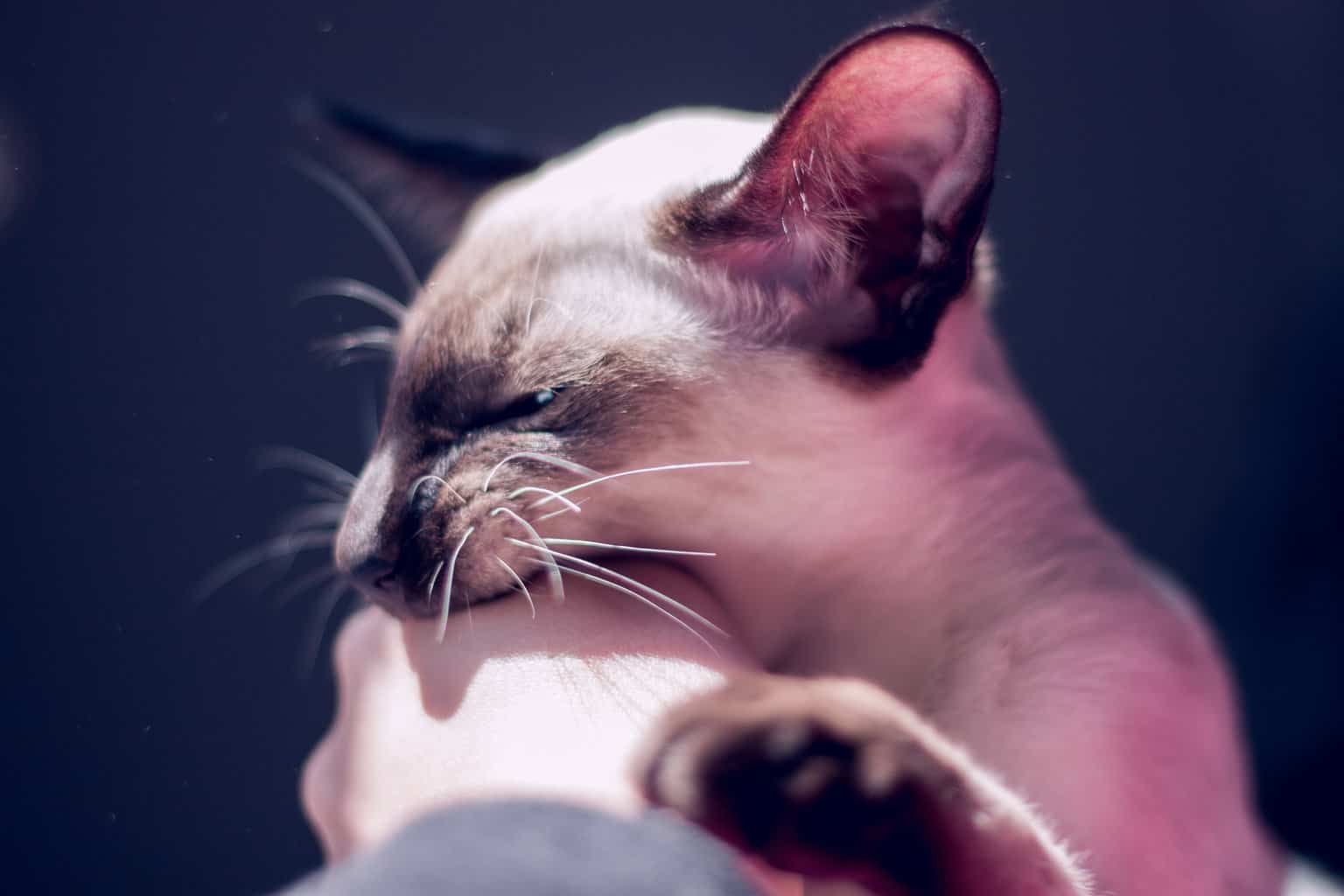
Why Does Your Siamese Cat Bite So Much?
Siamese cats are a popular breed for their distinct beauty and character, so you might be surprised to find out […]
-

Wedgehead Siamese Cats Versus Traditional Siamese Cats
Siamese cat breeds are consistently ranked in the top 2 or 3 of the most sought-after cats in the world […]
References
https://allaboutcats.com/strabismus-in-cats
https://siameseofday.com/is-it-normal-for-a-siamese-cat-to-be-cross-eyed/
https://favcats.com/cat-health/strabismus-in-cats/

